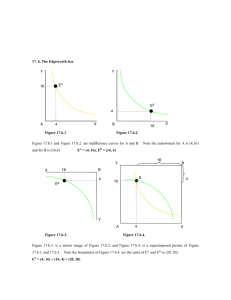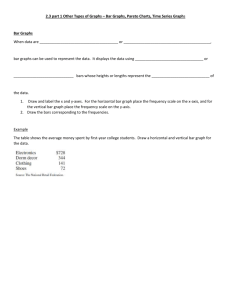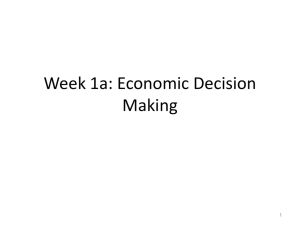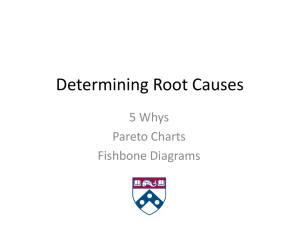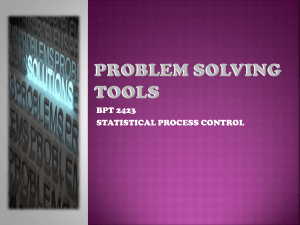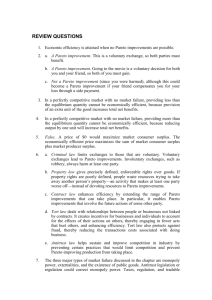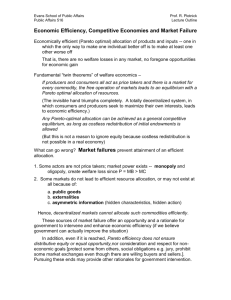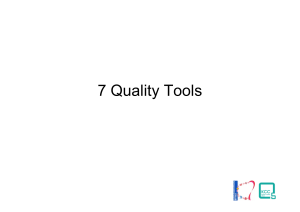efficiency - WikiEducator
advertisement
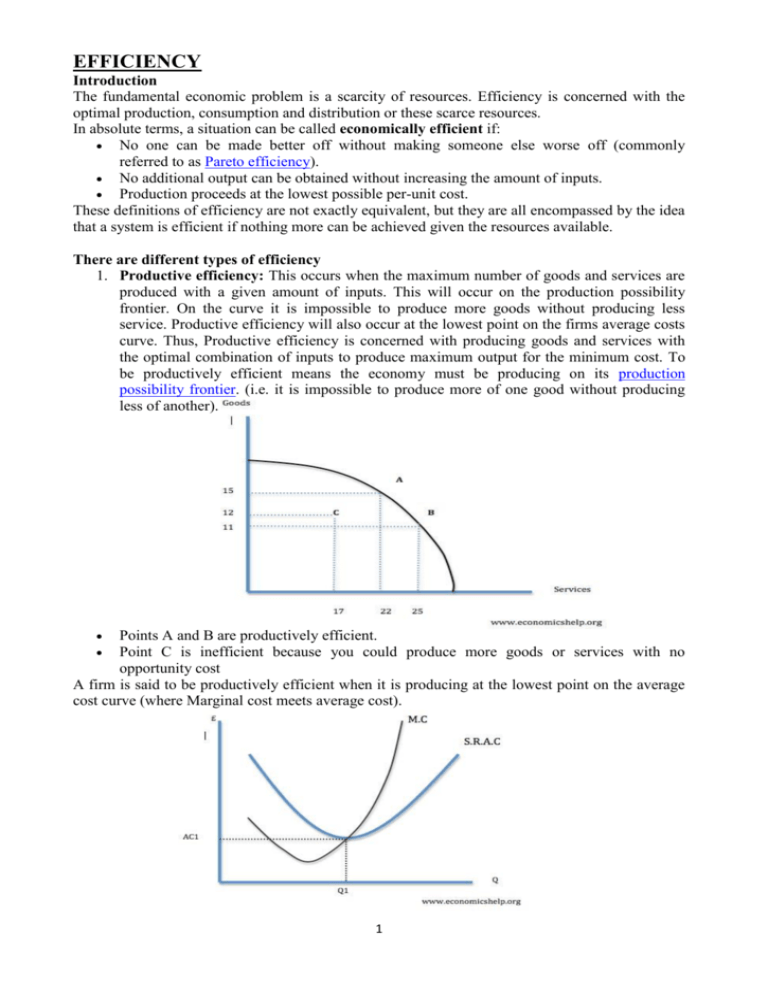
EFFICIENCY Introduction The fundamental economic problem is a scarcity of resources. Efficiency is concerned with the optimal production, consumption and distribution or these scarce resources. In absolute terms, a situation can be called economically efficient if: No one can be made better off without making someone else worse off (commonly referred to as Pareto efficiency). No additional output can be obtained without increasing the amount of inputs. Production proceeds at the lowest possible per-unit cost. These definitions of efficiency are not exactly equivalent, but they are all encompassed by the idea that a system is efficient if nothing more can be achieved given the resources available. There are different types of efficiency 1. Productive efficiency: This occurs when the maximum number of goods and services are produced with a given amount of inputs. This will occur on the production possibility frontier. On the curve it is impossible to produce more goods without producing less service. Productive efficiency will also occur at the lowest point on the firms average costs curve. Thus, Productive efficiency is concerned with producing goods and services with the optimal combination of inputs to produce maximum output for the minimum cost. To be productively efficient means the economy must be producing on its production possibility frontier. (i.e. it is impossible to produce more of one good without producing less of another). Points A and B are productively efficient. Point C is inefficient because you could produce more goods or services with no opportunity cost A firm is said to be productively efficient when it is producing at the lowest point on the average cost curve (where Marginal cost meets average cost). 1 Productive efficiency is closely related to the concept of Technical Efficiency. 2. Technical Efficiency: Optimum combination of factor inputs to produce a good: related to productive efficiency. Technical efficiency is the effectiveness with which a given set of inputs is used to produce an output. A firm is said to be technically efficient if a firm is producing the maximum output from the minimum quantity of inputs, such as labour, capital and technology. For example, a firm would be technically inefficient if a firm employed too many workers than was necessary or used outdated capital. The concept of technical efficiency is related to productive efficiency. Productive efficiency is concerned with producing at the lowest point on the short run average cost curve. Thus productive efficiency requires technical efficiency. The concept of technical efficiency is also related to X-inefficiency. 3. X inefficiency: This occurs when firms do not have incentives to cut costs, for example a monopoly which makes supernormal profits may have little incentive to get rid of surplus labour. Therefore a firms average cost may be higher than necessary. When there is this lack of incentives, the firm will not be technically efficient. X Efficiency would be when competitive pressures cause firms to combine the optimum combination of factors of production. Causes of X Inefficiency a. Monopoly Power: A monopoly faces little or no competition. Therefore, it might be easy for the monopolist to make supernormal profits. Therefore, in the absence of competitive pressures, they may not try very hard to control costs. b. State Control: A nationalised firm owned by the government may face little or no incentive to try and make profit. Therefore, it has less incentive to try and cut costs. Examples of X Inefficiency Employing workers who aren't necessary for the productive process. For example, a state owned firm may be more concerned about the political implications of making people redundant than getting rid of surplus workers. Lack of Management Control. If a firm doesn't have supervision of workers, then productivity may fall as workers 'take it easy' Not Finding Cheapest Suppliers. Out of inertia, a firm may continue to source raw materials from a high cost supplier rather than look for cheaper raw materials. 4. Pareto Efficiency/economic efficiency: We start with the following definition: if we can find a way to make some people better off without making anybody else worse off, we have a Pareto improvement. If an allocation allows for a Pareto improvement, it is called Pareto inefficient; if an allocation is such that no Pareto improvements are possible, it is called Pareto efficient. Pareto efficiency is however, a situation where resources are distributed in the most efficient way. It is defined as a situation where it is not possible to make one party better off without making another party worse off. Pareto efficiency is said to occur when it is impossible to make one party better off without making someone worse off. It is an economic state where resources are distributed in the most efficient way. Pareto efficiency will occur on a production possibility frontier. When an economy is operating on a simple production possibility frontier, (e.g. at Point A) it is not possible to increase output of Goods without reducing output of Services 2 However, at Point C (12 goods and 17 services). It is possible to increase either without leading to a decline in the output of the other. Thus to be at point C would be classed as Pareto inefficient, and this is generally considered to be bad for the economy. Pareto efficiency is related to the concept of productive efficiency. Productive efficiency is concerned with the optimal production of goods which occurs at the lowest point on the short run average cost curve and occurs on a PPF. Pareto efficiency is also concerned with allocative efficiency. To be pareto efficiency the distribution of resources needs to be at a point where it is impossible to make someone better off without making someone worse off. Examples of Pareto Efficiency To build a new airport may lead to a greater increase in social benefit than social cost. Therefore, there is a net gain to society. However, those people living near the new airport will lost out. Therefore this is not a pareto improvement. However, if the people living nearby were compensated for extra noise, then it is possible to have a pareto improvement. In practise there are often practical difficulties and high frictional costs in compensating losers from a particular project. Pareto Efficiency and Equity An outcome may be seen as a pareto improvement, but, it doesn't mean this is a satisfactory outcome or fair. There could still be inequality after a pareto improvement. 5. Allocative efficiency: This occurs when goods and services are distributed according to consumer preferences. An economy could be productively efficient but produce goods people don’t need this would be allocative inefficient. Allocative efficiency occurs when the price of the good = the MC of production. A more precise definition of allocative efficiency is at an output level where the price equals the Marginal Cost (MC) of production. This is because the price that consumer's are willing to pay is equivalent to the marginal utility that they get. Therefore the optimal distribution is achieved when the marginal utility of the good equals the marginal cost. Firms in Perfect competition are said to produce at an allocatively efficient level Monopolies can increase price above the marginal cost of production and are Allocatively inefficient. 3 Monopoly sets a price of Pm. This is allocatively inefficient because Price is greater than MC. Alloactive efficiency would occur at the point where the MC cuts the Demand curve so Price = MC. Note: Producing on the production possibility frontier is not necessarily allocatively efficient because a PPF is not concerned with distribution. This requires the addition of indifference curves 6. Static Efficiency: is concerned with the most efficient combination of resources at a given point in time. Static efficiency has two aspects. The first is that there is maximum output of goods given the volume of resources in the economy. Second, the goods produced must be a preferred combination. That is, these should reflect not only technical possibilities but the preference of consumers as well. Gold P C Q I B A D 0 P1 Cocoa For example, static efficiency involves the concept of productive efficiency - producing at the lowest point on the short run average cost curve - given existing resources and factor inputs. Static efficiency is also concerned with allocative efficiency - the best distribution of resources in an economy. However, in addition to a static concept of efficiency, there is also a dynamic efficiency. 7. Dynamic efficiency: This refers to efficiency over time. Dynamic efficiency involves the introduction of new technology and working practises to reduce costs over time. With this mind, we can define dynamic efficiency as an aspect of economic efficiency that measures the speed or the rate at which the production possibility curve moves from one static equilibrium point to another within a given period. For example, in the 1920s, the Ford motor factor were very efficient for that particular year. However, compared to later decades we cannot say that the production methods of 4 the 1920s were efficient. In other words, it is important for firms to make best use of given resources. But, they also need to develop greater use of resources over time. Y P2 Z Q P3 C F 3 B P1 Y1 E 2 A 1 X 8. Distributive Efficiency: Concerned allocating goods and services according to who 0 X1 Pwith 1 needs them most. Therefore, requires an equitable distribution. Distributive efficiency occurs when goods and services are consumed by those who need them most. Distributive efficiency is concerned with an equitable distribution of resources because of the law of diminishing marginal returns. The Law of diminishing marginal returns states that as consumption of a good increase we tend to get diminishing marginal utility. For example, if a millionaire already has three cars, but gets a fourth car - this fourth car will only increase his net utility by a small amount. If by contrast someone on a low income is able to get their first car, the marginal utility will be much higher. Therefore, to be distributively efficient, society will need to ensure an equitable distribution of resources. A monopoly could lead to distributive inefficiency. A monopoly is able to use its market power to set high prices and make super-normal profits. Thus a monopoly owner can gain a higher share of national output, but consumers face higher prices and a decline in consumer surplus. Conflict Between Distributive Efficiency and Economic Efficiency. Ensuring an equitable distribution of resources may cause economic disincentives. For example, if people on high incomes see very high rates of marginal tax, they may stop working or work in another country. Therefore, society may see less output. There is a trade off between increasing equity and causing disincentives to work and take risks. Generally, there is an assumption, a free market needs a degree of inequality to create some incentives for entrepreneurship etc 9. Social efficiency: is the optimal distribution of resources in society, taking into account all external costs and benefits as well as internal costs and benefits. Social Efficiency occurs at an output where Marginal Social Benefit (MSB) = Marginal Social Cost (MSC). Thus, social efficiency occurs when externalities are taken into consideration and occurs at an output where the social cost of production (SMC) = the social benefit (SMB). Social efficiency is closely related to the concept of Pareto efficiency – A point where it is impossible to make anyone better off without making someone worse off Note: Social benefit = private benefit + external benefit Social Cost = private cost + external cost Question: State and explain the various types of economic efficiency. 5


